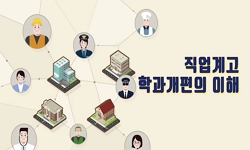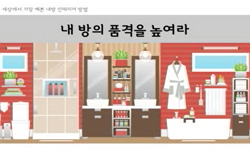문화 수준의 향상, 기술의 발전, 건축 공간 스케일의 거대화, 경험적 삶에 대한 추구 등 다양한 변화로 공간 환경의 중요성이 강조되면서 실내디자인 분야는 더욱 발전하고 있다. 그러나 실...
http://chineseinput.net/에서 pinyin(병음)방식으로 중국어를 변환할 수 있습니다.
변환된 중국어를 복사하여 사용하시면 됩니다.
- 中文 을 입력하시려면 zhongwen을 입력하시고 space를누르시면됩니다.
- 北京 을 입력하시려면 beijing을 입력하시고 space를 누르시면 됩니다.
실내디자이너 직무 특성에 관한 연구 : 4-6년 차 실내디자이너를 중심으로 = Job Characteristics of Interior Designers : Focused on 4th to 6th year Interior Designer
한글로보기https://www.riss.kr/link?id=T15067358
- 저자
-
발행사항
서울 : 건국대학교 건축전문대학원, 2019
-
학위논문사항
학위논문(석사) -- 건국대학교 건축전문대학원 , 실내건축설계학과 , 2019. 2
-
발행연도
2019
-
작성언어
한국어
- 주제어
-
발행국(도시)
서울
-
형태사항
105 ; 26 cm
-
일반주기명
지도교수: 심은주
-
UCI식별코드
I804:11004-200000175774
- 소장기관
-
0
상세조회 -
0
다운로드
부가정보
국문 초록 (Abstract)
이에 본 연구의 목적은 실내디자이너의 구체적인 직무 내용과 프로세스 특성과 직무 영역 내 능력 단위별 수행 빈도, 중요도, 난이도는 분석하고 이에 따른 상관관계를 정리하는 목적이 있다. 그러나 실내디자이너의 직무 특성은 실무 경력에 따라 편차가 클 수 있기에 본 연구는 국가직무능력표준(NCS)에서 ‘디자이너’ 직위로 분류된 4-6년의 직무 경험을 가진 실내디자이너들로 그 대상을 한정하였다. 특히 심층 인터뷰의 연구 방법을 사용하여 직무를 수행하는데 필요한 지식, 기술, 능력(K.S.A) 등에 관한 그들의 이야기를 기록하고 정리하여 그에 따른 대비와 활용에 도움이 되는 기초 자료를 제공하고자 한다.
연구의 방법은 다음과 같다. 첫 번째 연구 방법으로 이론 고찰을 통해서 실내디자인의 개념과 실내디자이너의 직무 현황, 그리고 직무 내용과 프로세스를 이해하였다. 두 번째 연구 방법으로 4-6년 차 실내디자이너 10명을 인터뷰 대상자로 선정하여 설문형 인터뷰, 대화형 인터뷰로 구성된 2가지 유형의 심층 인터뷰를 병행하였다.
연구의 결과는 인터뷰 대상자들은 프로젝트의 시작부터 마감까지의 전체 직무 영역을 광범위하게 수행하고 있었으나 운영 관리 관련 영역과 시공 협력 업체와의 협업이 요구되는 협력 설계 영역 부분은 거의 하지 않는 것으로 드러났다. 그리고 인터뷰 대상자들은 프로젝트와 관련된 각종 자료를 수집하고 분석하는 책무들을 가장 빈번하고 중요하게 인식하고 있었는데 그 가운데 관계 법령들을 검토하고 조사하는 책무를 가장 어려워하는 것으로 확인할 수 있었다. 이러한 영역에 대한 사전 지식과 교육 등이 부족하여 낯설고 어려워하는 것이라 사료된다. 또한 그들에게 요구되는 기술은 2D, 3D의 디지털 표현 기술과 설득력 있는 대화의 기술로 드러났으며 디자인 문제 해결 능력과 상황 대처 능력이 중요한 능력으로 요구되고 있었다. 마지막으로, 심층 인터뷰의 대상자에 해당되는 4-6년 차 실내디자이너들은 폭넓은 직무 영역의 범주를 수행하고 있었으며, 순차적이고 동시다발적인 직무 프로세스 특성을 갖고 있었다.
문화 수준의 향상, 기술의 발전, 건축 공간 스케일의 거대화, 경험적 삶에 대한 추구 등 다양한 변화로 공간 환경의 중요성이 강조되면서 실내디자인 분야는 더욱 발전하고 있다. 그러나 실내디자인이 기본적으로 건축, 디자인, 예술, 공예 등의 통합적 속성을 갖고 있을 뿐만 아니라 최근 발생된 광고, 마케팅, 디지털 미디어 등의 세분화된 전문 분야와의 협업이나 공간 복합화 등의 추세에 힘입어 그 융합적 디자인 패러다임은 어느 때보다 강해지고 있다. 따라서 전문가로서의 실내디자이너에게 기대하는 역할과 책임은 날로 증가하고 있다. 그러나 실내디자이너는 이에 비해 그들의 직무 내용과 범위에 관한 연구는 미미한 실정이다. 특히 실무 현장의 최일선에서 활발하게 직무 활동을 펼치는 실내디자이너들의 직무에 대한 구체적 연구는 더욱 부족하다.
이에 본 연구의 목적은 실내디자이너의 구체적인 직무 내용과 프로세스 특성과 직무 영역 내 능력 단위별 수행 빈도, 중요도, 난이도는 분석하고 이에 따른 상관관계를 정리하는 목적이 있다. 그러나 실내디자이너의 직무 특성은 실무 경력에 따라 편차가 클 수 있기에 본 연구는 국가직무능력표준(NCS)에서 ‘디자이너’ 직위로 분류된 4-6년의 직무 경험을 가진 실내디자이너들로 그 대상을 한정하였다. 특히 심층 인터뷰의 연구 방법을 사용하여 직무를 수행하는데 필요한 지식, 기술, 능력(K.S.A) 등에 관한 그들의 이야기를 기록하고 정리하여 그에 따른 대비와 활용에 도움이 되는 기초 자료를 제공하고자 한다.
연구의 방법은 다음과 같다. 첫 번째 연구 방법으로 이론 고찰을 통해서 실내디자인의 개념과 실내디자이너의 직무 현황, 그리고 직무 내용과 프로세스를 이해하였다. 두 번째 연구 방법으로 4-6년 차 실내디자이너 10명을 인터뷰 대상자로 선정하여 설문형 인터뷰, 대화형 인터뷰로 구성된 2가지 유형의 심층 인터뷰를 병행하였다.
연구의 결과는 인터뷰 대상자들은 프로젝트의 시작부터 마감까지의 전체 직무 영역을 광범위하게 수행하고 있었으나 운영 관리 관련 영역과 시공 협력 업체와의 협업이 요구되는 협력 설계 영역 부분은 거의 하지 않는 것으로 드러났다. 그리고 인터뷰 대상자들은 프로젝트와 관련된 각종 자료를 수집하고 분석하는 책무들을 가장 빈번하고 중요하게 인식하고 있었는데 그 가운데 관계 법령들을 검토하고 조사하는 책무를 가장 어려워하는 것으로 확인할 수 있었다. 이러한 영역에 대한 사전 지식과 교육 등이 부족하여 낯설고 어려워하는 것이라 사료된다. 또한 그들에게 요구되는 기술은 2D, 3D의 디지털 표현 기술과 설득력 있는 대화의 기술로 드러났으며 디자인 문제 해결 능력과 상황 대처 능력이 중요한 능력으로 요구되고 있었다. 마지막으로, 심층 인터뷰의 대상자에 해당되는 4-6년 차 실내디자이너들은 폭넓은 직무 영역의 범주를 수행하고 있었으며, 순차적이고 동시다발적인 직무 프로세스 특성을 갖고 있었다.
다국어 초록 (Multilingual Abstract)
The purpose of this study is to analyze the detailed job descriptions and process of interior designers, and the frequency, importance and difficulty of each unit of capacity in the job domain and to establish the correlation that arises accordingly. However, this study set its focus on interior designers who are classified as 'designer' in the national incompetence standard (NCS) and have 4-6 years of work experience because specific jobs may vary widely depending on each designer’s career experience. Most importantly, this study is intended to provide basic data that can be helpful for the preparation and the use of the designers’ stories about the knowledge, skills, and competence (KSA) necessary to complete their jobs, recorded and organized through in-depth interviews.
The research was carried out in the following ways. Using theoretical review as the first method, the concept of interior design, the current job state of interior designer, job descriptions and process were identified and comprehended. Next, as a second research method, 10 interior designers in their 4th to 6th year were selected as interviewees to participate in two forms of interviews in parallel, survey-type and interactive.
The study shows that the interviewees were fulfilling the entire scope of jobs from the start to the end of the project, but they were found to engage little in the areas of operational management and cooperative design that requires collaboration with partner constructors. Moreover, the interviewees most frequently considered their jobs of collecting and analyzing different project-related data the most significant. Among the tasks, examination and investigation of the relevant laws were reported to be the most difficult. It is understood that they don’t feel familiar and comfortable with such task due to lack of prior knowledge and education about these areas. In addition, the technology required for them was found to be 2D and 3D digital display technologies and persuasive conversation techniques. Also, the ability to solve design-related problems and cope with various situations was regarded as equally crucial. Last of all, the 4th- to 6th-year interior designers, who took part in the in-depth interviews, were engaging in a wide range of job categories and their job process was both consecutive and simultaneous.
The field of interior design is developing substantially as the importance of spatial environment grows due to various changes such as raised cultural standards, technological advancements, expanded scale of architectural space, and pursuit of experie...
The field of interior design is developing substantially as the importance of spatial environment grows due to various changes such as raised cultural standards, technological advancements, expanded scale of architectural space, and pursuit of experiential life. However, the convergence paradigm of design is becoming stronger than ever, not only because interior design is inherently wide-ranging, embracing architecture, design, arts, and crafts, but also because of a recent trend towards spatial diversification or collaboration with specialized sectors such as advertising, marketing, and digital media. Therefore, the expectations for the roles and responsibilities of professional interior designers are ever-increasing. Yet, there is little research on the descriptions and the scope of their jobs. In particular, there is a stark lack of concrete research on the jobs of interior designers who are actively working at the forefront of the field.
The purpose of this study is to analyze the detailed job descriptions and process of interior designers, and the frequency, importance and difficulty of each unit of capacity in the job domain and to establish the correlation that arises accordingly. However, this study set its focus on interior designers who are classified as 'designer' in the national incompetence standard (NCS) and have 4-6 years of work experience because specific jobs may vary widely depending on each designer’s career experience. Most importantly, this study is intended to provide basic data that can be helpful for the preparation and the use of the designers’ stories about the knowledge, skills, and competence (KSA) necessary to complete their jobs, recorded and organized through in-depth interviews.
The research was carried out in the following ways. Using theoretical review as the first method, the concept of interior design, the current job state of interior designer, job descriptions and process were identified and comprehended. Next, as a second research method, 10 interior designers in their 4th to 6th year were selected as interviewees to participate in two forms of interviews in parallel, survey-type and interactive.
The study shows that the interviewees were fulfilling the entire scope of jobs from the start to the end of the project, but they were found to engage little in the areas of operational management and cooperative design that requires collaboration with partner constructors. Moreover, the interviewees most frequently considered their jobs of collecting and analyzing different project-related data the most significant. Among the tasks, examination and investigation of the relevant laws were reported to be the most difficult. It is understood that they don’t feel familiar and comfortable with such task due to lack of prior knowledge and education about these areas. In addition, the technology required for them was found to be 2D and 3D digital display technologies and persuasive conversation techniques. Also, the ability to solve design-related problems and cope with various situations was regarded as equally crucial. Last of all, the 4th- to 6th-year interior designers, who took part in the in-depth interviews, were engaging in a wide range of job categories and their job process was both consecutive and simultaneous.
목차 (Table of Contents)
- 제1장 서론 1
- 제1절 연구 배경과 목적 1
- 제2절 연구 범위 2
- 제3절 연구 문제 4
- 제2장 실내디자인의 개념과 직무에 관한 이론고찰 5
- 제1장 서론 1
- 제1절 연구 배경과 목적 1
- 제2절 연구 범위 2
- 제3절 연구 문제 4
- 제2장 실내디자인의 개념과 직무에 관한 이론고찰 5
- 제1절 직무 분석 개념과 방법 5
- 1. 직무 분석 개념과 목적 5
- 2. 직무 분석 정보의 수집 방법 8
- 3. 직무 분석 선행연구 분석 12
- 제2절 실내디자인의 개념과 현황 16
- 1. 국내·외 실내디자인의 형성 배경과 개념 16
- 2. 실내디자인 분야의 분류 체계 20
- 3. 실내디자이너의 직무 현황 22
- 제3절 실내디자이너의 직무 내용과 프로세스 25
- 1. 실내디자이너의 직무 내용 25
- 2. 실내디자이너의 직무 프로세스 29
- 제4절 소결 33
- 제3장 연구 설계 35
- 제1절 연구 방법 35
- 1. 심층 인터뷰의 방법 35
- 2. 심층 인터뷰의 설계 37
- 제2절 심층 인터뷰의 구성 39
- 1. 연구 대상 39
- 2. 연구 도구 41
- 3. 연구 구성 43
- 4. 자료 수집 과정 및 분석 45
- 제3절 신뢰도 및 타당도 확보 47
- 제4절 소결 49
- 제4장 심층 인터뷰의 분석 및 결과 52
- 제1절 직무 프로세스 특성 52
- 1. 실내디자인 운영 관리 52
- 2. 실내디자인 자료 조사 54
- 3. 실내디자인 기획 및 공간계획 56
- 4. 실내디자인 프레젠테이션 58
- 5. 실내디자인 설계도서 작성 59
- 6. 실내디자인 가구, 마감, 색채, 조명 계획 60
- 7. 실내디자인 설비 계획 및 협력 설계 61
- 8. 실내디자인 시각화 작업 62
- 제2절 능력 단위별 분석 64
- 1. 직무의 수행 빈도 64
- 2. 직무의 중요도 67
- 3. 직무의 난이도 69
- 제3절 요구 되는 지식, 기술, 능력(K.S.A) 분석 73
- 1. 지식(Knowledge) 73
- 2. 기술(Skills) 76
- 3. 능력(Abilities) 79
- 제4절 소결 83
- 제5장 결론 85
- 참고문헌 88
- 부 록 91
- 국문초록 104












